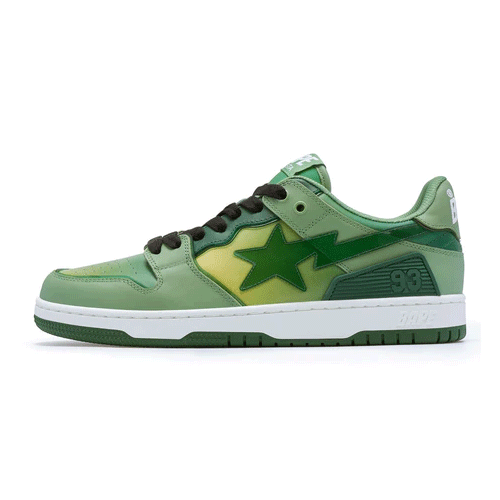When it comes to streetwear legends, few sneakers have the same cultural clout as the Bapesta. Born out of Japan’s revolutionary streetwear brand A Bathing Ape (BAPE), the Bapesta has carved out its place in fashion history, recognized as both a statement piece and a collector’s item. Known for its bold design, vibrant colorways, and unmistakable star logo, the Bapesta is much more than a shoe—it’s a symbol of self-expression, creativity, and the global fusion of hip-hop and fashion.
Whether you’re a long-time sneakerhead or new to the game, understanding the journey of the Bapesta is key to appreciating its influence. From its controversial roots to its present-day revival, this sneaker’s story is deeply woven into the fabric of modern streetwear.
The Origins of Bapesta: A Japanese Streetwear Milestone
The Bapesta was first released in 2002 by Nigo, the founder of A Bathing Ape. By then, BAPE had already gained notoriety in Japan for its limited-edition drops, camouflage prints, and exclusivity. Inspired by American hip-hop culture and the iconic Nike Air Force 1, Nigo set out to create a sneaker that would bridge East and West, offering something familiar yet completely original.
Visually, the Bapesta closely mirrors the Air Force 1 in silhouette, but it replaces the Swoosh with a lightning star—a design known as the “STA”—and incorporates wild colors, patent leather, and bold branding. It was this fusion of familiar form and loud expression that made the Bapesta a hit, especially among fans of urban fashion and rap music.
Bapesta and the Hip-Hop Connection
The early 2000s were a golden age for hip-hop fashion, and the Bapesta arrived at the perfect moment. American rappers quickly adopted the shoe, giving it global exposure. Pharrell Williams, Kanye West, Lil Wayne, and Soulja Boy were some of the earliest and most vocal supporters of BAPE and the Bapesta sneaker.
Kanye, in particular, played a pivotal role in elevating the brand’s status when he collaborated with Nigo to create his own Bapesta colorway, featuring the iconic “Dropout Bear” artwork. This wasn’t just a fashion moment—it was a cultural crossover that signaled the global reach of streetwear.
The Bapesta became a must-have item in music videos, on red carpets, and in sneaker collections. It blurred the lines between luxury, streetwear, and music, further solidifying its legacy in the fashion world.
Design Aesthetics That Set Bapesta Apart
One of the most distinctive traits of the Bapesta is its unapologetic embrace of loud, flashy aesthetics. At a time when many sneakers leaned towards minimalism, the Bapesta doubled down on boldness. Patent leather finishes, candy-colored palettes, metallic shines, and graphic patterns were not just accepted—they were celebrated.
The signature Bapesta star (or “STA”) logo, often placed in clashing colors, added a playful yet aggressive look to the silhouette. The midsole branding, usually printed with the word “BAPE,” further reinforced the shoe’s streetwear credentials.
Over the years, the brand has experimented with countless variations—from camo-covered versions to animal print editions, collaborations with artists, and even luxury leather versions that appeal to more premium markets. This diversity has kept the Bapesta fresh and in demand across generations.
Controversy and Criticism: Copy or Homage?
No conversation about the Bapesta would be complete without addressing the Nike Air Force 1 comparisons. Critics have long accused BAPE of ripping off Nike’s design, and indeed, the resemblance is unmistakable. The shape, sole, and panel structure are strikingly similar.
However, Nigo has always been transparent about the influence. In interviews, he’s described the Bapesta as an homage rather than a bootleg. In Japanese streetwear culture, remixing and reinterpreting existing forms is a common design practice, rooted in appreciation rather than theft. Despite initial backlash, the sneaker has achieved a legitimacy of its own through brand storytelling, exclusivity, and cultural integration.
Today, it’s seen as a unique entity—distinct in its styling and rooted in a different context than its American counterpart.
Modern Bapesta Releases: Staying Relevant in a Saturated Market
While the Bapesta initially faded from the mainstream spotlight in the mid-2010s, the recent streetwear resurgence brought it roaring back. With Gen Z rediscovering Y2K fashion and a growing appetite for nostalgic designs, BAPE smartly reintroduced the Bapesta with both retro colorways and new twists.
Recent collaborations have included partnerships with artists like Kid Cudi and brands such as Coach, Undefeated, and even Marvel. These collabs often drop in limited numbers, reigniting the hype-driven model that BAPE was known for.
In 2021, BAPE even debuted a retooled version of the Bapesta with slightly updated construction and fit, showing the brand’s commitment to staying current while respecting its roots.
How to Style the Bapesta: Fashion Tips for Sneakerheads
The Bapesta’s bold design can seem intimidating to style, but it’s also an incredibly versatile statement piece when done right. Pair it with neutral cargo pants, oversized hoodies, or graphic tees to let the shoes shine. For a more elevated look, match a monochrome Bapesta with tailored joggers or cropped denim and layer with a bomber jacket or varsity coat.
Thanks to its wide range of colors and materials, there’s a Bapesta for almost every vibe—from loud and eccentric to clean and minimal. Don’t be afraid to mix prints or play with proportions. The Bapesta thrives in spaces where fashion meets attitude.
Where to Buy Bapestas: Authenticity Matters
Given its popularity and exclusivity, the Bapesta is frequently counterfeited. To ensure you’re getting the real deal, it’s best to buy from official BAPE stores, authorized retailers, or trusted resale platforms. Always verify authenticity through stitching quality, box labels, and patent leather material.
Prices can vary dramatically depending on rarity, collaboration, and condition. While general releases might go for retail, limited editions or vintage pairs can fetch hundreds—if not thousands—on the secondary market.
The Legacy of Bapesta in Sneaker Culture
The Bapesta is more than just a sneaker—it’s a time capsule of early 2000s fashion, a symbol of East-meets-West creativity, and a testament to the power of cultural influence. Its ability to spark conversations, define eras, and remain relevant decades later proves its iconic status in the sneaker world.
As the lines between fashion, music, and streetwear continue to blur, the Bapesta stands as a pioneer—a shoe that wasn’t afraid to be loud, different, and disruptive. It laid the groundwork for how brands now approach collaborations, drop culture, and storytelling.
Final Thoughts
Whether you’re investing in your first pair or adding to an already stacked sneaker rotation, the Bapesta is a piece of fashion history worth owning. With its fearless design, celebrity co-signs, and roots in hip-hop and Japanese culture, it remains one of the most influential sneakers of all time.



